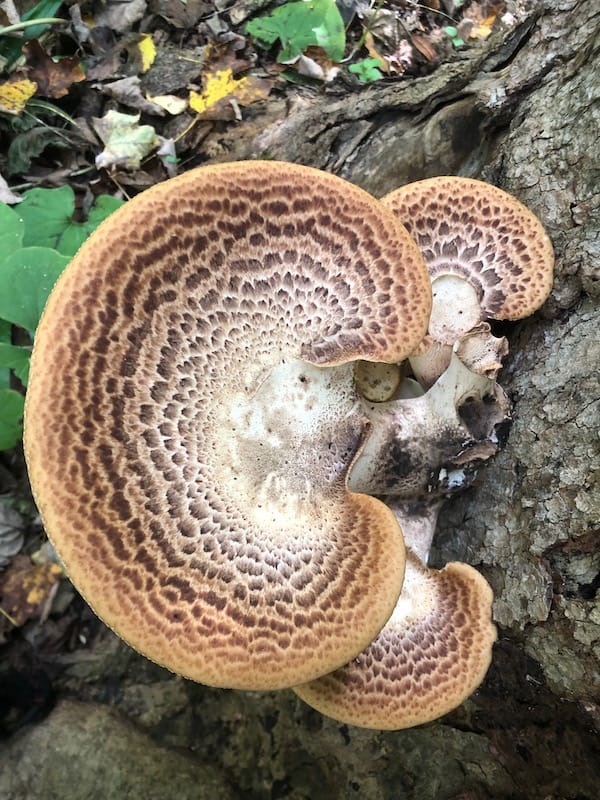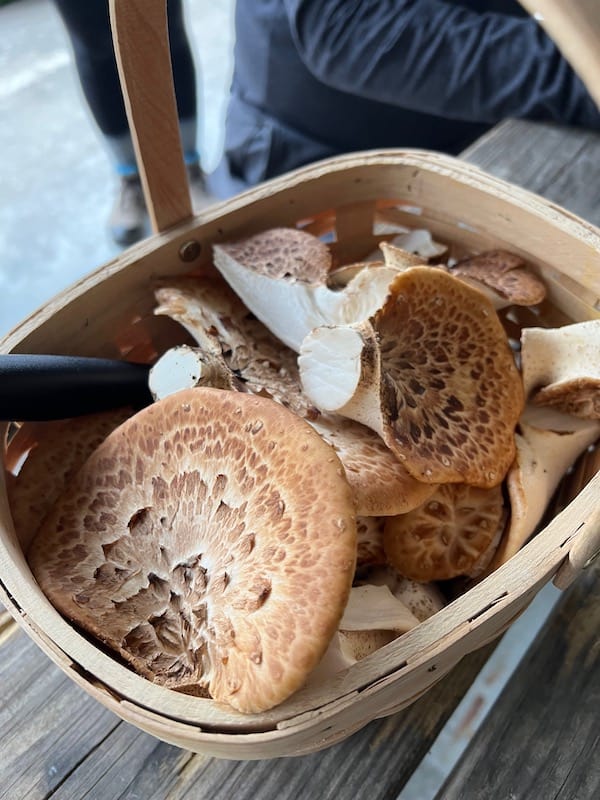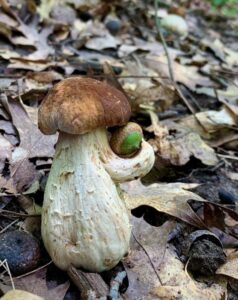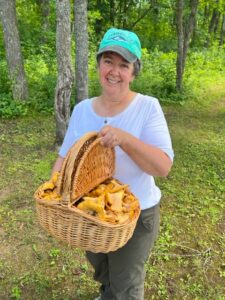I’m Bringing Pheasant Back!
By Mike Tangedal
Here’s another cooking article I wrote inspired by all the requests I’m getting in my feed on how to cook the first mushroom of the season – Cerioporus squamosus – the pheasant back/dryad’s saddle.
During the early days of my education in the culinary arts, I read an article noting the definitive and scientifically credible means to make the best french fries. I was intrigued and inspired to recreate the process since it involved little additional expense, but it did involve additional time and technique. So the quick review is that first you need to soak the raw cut fries, then fry them in oil once at a certain temperature, and then fry them again at a hotter temperature. It takes lots of time and effort to make great fries.
I’ve dismissed so many recipes over the years due to excessive commitments of time, technique, and/or ingredients. I’m sure some overly-sophisticated recipe exists using truffles, but most of us love the simple sautéed mushroom. However, simplicity sometimes does not produce the best results.
With both our Minnesota state fish and state mushroom, simple is best. As with the walleye, the best morel preparation is a simple sauté in butter, followed by finishing with salt and pepper. Simple is best in this case. But we are just at the beginning of morel season, and Cerioporus squamosus is already out and will be throughout the year. These are the mushrooms we ignore in our quest for morels. So I’m here to provide the definitive methodology for cooking them. If you follow this procedure, it will be analogous to moving from plain old french fries to the best french fries. However, this procedure will not require excessive time or technique.
Thankfully, the pheasant back, or Dryad’s saddle mushroom, is highly identifiable. It’s a classic beginner mushroom and the first wild mushroom I ever cooked. No toxic look-alikes can be found in Minnesota. It’s also quite easy to find. It’s always found on dead wood, usually quite close to the ground. It can also grow to be quite sizable, often more than a foot across, in the shape of a large disc. This is all the better reason to harvest them early in the season when they are emerging. Avoid large specimens, especially in the summer and fall, as they no doubt will be infested with insect larvae on their porous underside.
Another distinctive attribute of the Pheasant Back is its pleasant smell – much like a melon rind. Larger varieties will have a tough, rubbery interior, so when harvesting the large ones, it’s best to cut a swath a few inches from the edge. If it’s tender enough to tear by hand and not full of bug holes, then it’s fine to eat. This variety of mushroom is also known to have a rather unremarkable flavor. Why eat a plain hot dog when gourmet mushroom morels are also around? Well, there are hot dogs, and then there are gourmet hot dogs. I’m about to show you how to add all the flavor to your Pheasant Back.
As noted before, delicate mushrooms like the morel are fine with a simple sauté. But the hyphae structure within Cerioporus squamosus is much more dense and benefits from more aggressive cooking. We all know browning food brings about deeper flavors, and such is the case with Pheasant Back. Prepare to have the tastiest, boring, ordinary mushroom ever!
Step 1. Cleaning
Ceriporus squamosus is among the types of porous mushrooms with a spore-producing layer under the cap called the hymenium. The function of this tissue in these mushrooms is to simply create spores. They really don’t add much flavor, and their texture can be off-putting even when cooked. So when harvesting larger examples, it’s best to scrape off the underside layer with the back of your mushroom knife. This serves a dual purpose, as this action indicates if bugs have burrowed into the mushroom. Discard any with bugs. They ruin the taste of the mushrooms. Also, clean any dirt or leaves off as best as can be done, and remove any parts that feel tough. Once cleaned, cut into strips about a half inch wide.
Step 2. Water removal
Mushrooms contain a substance called chitin, which is rigid and, along with the hyphae, gives them their structure. This structure is sponge-like and retains a lot of water. In order to create tasty, crispy, browned mushrooms and not just mushroom mush, the first order of business is to get that water out. Ironically, this is done by first adding a bit of water to the process.
This entire step is going to add only 5-10 minutes to the cooking procedure but is going to make a big difference. Once the mushrooms are cleaned, put the biggest frying pan you own on medium heat and add a few tablespoons of water. Once the water starts to boil, toss in the mushrooms. This may take a few rounds, as one can find many pounds of Pheasant Backs in a hurry. Add as many mushrooms as will fit in the pan while still being able to stir without spillage.
Stir constantly while cooking. This is important for three reasons. First, you want to move the mushrooms around so that all sides are exposed to the heat. Second, you want to agitate the mix to knock off any remaining dirt or foreign material. Lastly, you want to be attentive so you know when all the liquid is gone and can stop cooking immediately
Step 3. Reset the pan
Immediately after the water is gone from the pan, take a spatula and dump the mushrooms into a bowl. Then take a paper towel and wipe the pan. Once the pan is clean again, repeat the water removal process for the rest of the mushrooms. Once this entire first cooking step is done and the pan is clean, add a bit of high temperature oil to the pan and return it to mid to high heat.
Inasmuch as we all know how much mushrooms love butter, butter has a relatively low smoke point, so it’s not the fat of choice for this method. The cheapest option is canola oil, but a great option is clarified butter or ghee. Ghee is widely available and has all the tasty components of butter but with a higher heat capacity.
Step 4. Browning
Remember when I noted that the internal structure of mushrooms resembled a sponge? Well, by first getting rid of all the water, the sponge structure has essentially collapsed, so additional cooking with oil will not cause the mushrooms to just soak up all the fat. We all appreciate how food cooked in a wok under high heat and in a very quick manner tastes so good due to the quick browning. This is how to finish these Pheasant Backs. In fact, a big wok would work every bit as well as a frying pan for this process.
Once the fat in the pan is quite hot (at least 350 degrees), add the mushrooms and stir vigorously. They will cook quickly and be done in under a few minutes. Once they are brown, add salt and season to taste, and then they are done. I’ve seen those who do not salt their mushrooms, and this makes no sense to me. It’s like not salting fries.
The lowly Pheasant Back really shines after this process since it has the density to stand up to such a vigorous cooking method. This turns peasant fare into a gourmet delight! It only adds about 10 minutes to a regular mushroom cooking process with no additional expense. Try it once, and you’ll be hooked.




